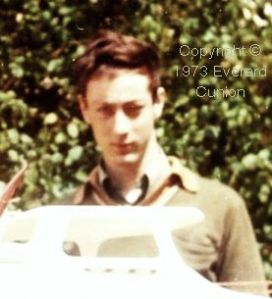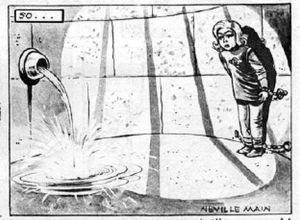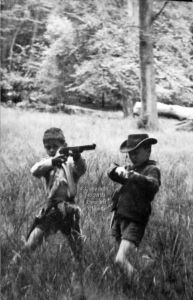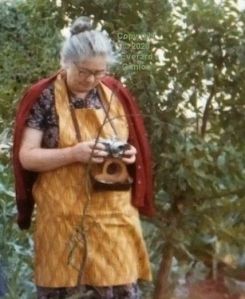Home (contents) → Miscellaneous → About the author
About the author
I am a hang glider pilot, photographer, and amateur philosopher. My profession is software engineering. See Programming career for brief details of the latter.
London
The image of Venus in a dungeon is from the series Fireball XL5 in TV Comic, week ending December 15th, 1962. I lay awake nights wanting to save her as the water rose to the level of her breasts. When I grew up, I would replace Steve Zodiac at the controls of XL5 and, assuming one of us saved her from the dungeon, I would then possess Venus and my life would be complete. See Night flight to Venus, my Comet Miniatures 1/200th scale Fireball XL5.
As darkness settled on a deserted main street in London where we waited during the severest winter in Britain for 200 years, the cold seeped into my young bones and I willed a brown London Transport bus to appear. A brown London Transport bus? The yellow sodium street lights of the time turned the red into brown, no matter how hard you looked.
The Big Freeze began on December 26th, 1962 according to a television documentary made shortly afterward and available on YouTube (see under External links later on this page). Warm air arrived on January 26th, but three days later, the freeze resumed. Therefore, it might be on or about January 29th that my brother and I were out with our mum, shopping maybe, or perhaps we went to the cinema (movie theater).
Unknown to us, there was a ‘wildcat’ transport strike. The temperature dropped, there were no pedestrians out, and ever fewer vehicles passed by until, eventually, that shopping street was empty except for us. I tried sheltering from the cold in a short corridor between store fronts that led to the store-front door — common in London in those days. The stores remained lit at nights and promised warmth, drawing me in as a cave man (boy) is drawn to the camp fire presumably, but it was equally cold between the store front windows. Eventually a bus arrived and mum flagged it down and we got on. Was it going the right way for us? It did not matter. Our mum was not very good at providing us boys with adequate clothing. She did not feel the cold as we did, but she knew that we were freezing to death that evening. The driver told us to sit in the front seats just behind his cab. That was where the heater was. We were saved. There were no other passengers and he took us to the Nag’s Head junction bus stop a short walk from home.
Buses then had a crew of two; a driver and a conductor, who took your fare and issued a ticket from a machine hung around his or her neck. However, as I recall, there was only a driver on that bus.

London buses on 9 December, 2005. The one on the right is a 1960s bus. Photo from Wikipedia by Jon Bennett – Originally posted to Flickr as The last day of the RM, CC BY 2.0, https://commons.wikimedia.org/w/index.php?curid=4546425.
This photo fails to show the way that, at night, the yellow sodium street lights of the time turned the red into brown. The radiator grill identifies it as a diesel bus. The one that saved us was more likely a gasoline (petrol) bus with a narrower nose.
As a socialist, I am in favour of unions and the right to withdraw labour — within reason — but our lives were saved that day by a lone strike breaking bus driver.
This view from our back window in north London was before the Post Office (Telecom) tower was built. Boeing 707s flew overhead.
See under External link later on this page for a comedy set in 1960s London that illustrates where I grew up until about eight years old.
We took the steam train down from London to where our grandparents (on my mother’s side) had retired on the south coast. Eventually, we moved in with them. At eight years old I was surrounded by fir trees, sandstone ridges and quarries, and disused air raid shelters – instead of (or rather, as well as) streets of houses and shops. It was far less confining than a north London street, but the move came with a cost that soon became apparent, even to me at that age. North London in the early 1960s was not the intellectual and cosmopolitan utopia of popular belief though. A random counter example was Margaret, one of our next door neighbors (in those multi-story apartments) who my mother often heard crying at night over her baby son, blinded in one eye by other children wielding sticks when she left him unattended in his pram in the street while she went into a shop.
…he drew the symbols of provincial life (a calendar draped in spider webs) and of Parisian life (a speedometer powered by a 300-horsepower engine, held in place by a naked woman).
— Stacy Schiff, Saint-Exupéry, a Biography, 1994
Under fire
Our old dad, who fought in World War 1, taught us better weapons handling than we display in the photo. (See Personal and other trivia, a sub-page of my review of the 2011 Zack Snyder movie Sucker Punch for more of my father at that time.) Incidentally, illustrating the compressed history of the USA, some of the U.S. Army generals in that war had fought against the Indians (native Americans) on the arbitrarily defined and ever shifting ‘frontier’ late in the previous century.
Crossing a plateau of waist-deep heather on a lower slope of a nearby hill in about 1965 with my brother and school friends one day, we were surrounded by buzzing and several thwacks – then the staccato of what sounded like automatic fire. (It was rifle and/or pistol fire by several shooters simultaneously, which the mind seems to perceive as automatic fire, likely from watching too many war films on television.) We lit out of there and they moved the firing range to a safer location soon after. To this day the cool still air of summer mornings carries the sound to us from that (safer) outdoor firing range. (See Old firing range in On the hill part 2: North, east, and west for photos of it in 2021.)
We were under fire in other ways too, or perhaps more like secret agents parachuted behind enemy lines. It was like going back 200 years. For example, we lived opposite a hospital and, when we first moved there, an occasional black or Indian doctor would walk down the street. When they did, often the proverbial ‘little old ladies’ stopped and watched them go by. They had never seen a coloured person before except, presumably, on television.
I carried on making plastic model airplanes, a pastime that I had started in London. Showing my newly completed Airfix 1/72nd scale F-4 Phantom to my grandmother, she commented that airplanes were OK to look at, “But you keep out of them.” As it turned out, I largely complied with that injunction. I became a hang glider designer and test pilot instead…
😀
That was several years later, however. In 1966, nobody had heard of a hang glider. Not in Britain anyway.
This is what we’ve waited for
This is it, boys, this is war.
— from the lyrics of 99 Red Balloons by Nena, 1984
At school I looked forward to flying F-111s in Vietnam. Then the RAF cancelled its order for F-111s and Britain, unlike Australia and New Zealand, did not follow the Americans into Vietnam. (Rightly, I think now, but all I wanted was to be a flying superhero, which — until hang gliding appeared — required a war.) Then I wanted to be a top motorcycle trials rider like the guys who practised on my local hill. I was unable to afford a good bike and I am the world’s worst mechanic, so I was unable to keep an old bike running. (See Off-road bikes.)
During the first moon landing in the summer of 1969, I was 13 years old. (See T minus 15 seconds, guidance is internal, my review of First Man, Universal Pictures, 2018, about the first moon landing.) At the same time, a big event in the UK was the Daily Telegraph/BP Round-Britain powerboat race. I cut out photos of the event from the newspaper and stuck them to my bedroom wall. See Round-Britain powerboat race 1969.
As a male in your late teens in Britain of those days, you either went into the military or further education. I went to sixth-form college because I found physics easy and I am grateful for the way they unobtrusively made leeway for this troubled and troublesome individual. (I do not recall being troublesome, or much else of that time, but I assume I must have been.)
One of John Steinbeck’s punchy short stories that sticks in my mind is Flight, which illuminates the burdens that women in general and mothers in particular endure, and the unimaginable pain they sometimes have to bear. I am sure I am so haunted by that story because its central male viewpoint character is so much like me — or like I used to be at 18 years old, as he is in the story. See Flight (John Steinbeck story) for more.

Me in 1973
While I believe I still hold a rifle accuracy record from sixth form college (all the bullets from the magazine went through the same ragged hole in the target – which I still have) shooting was not really my thing. Hang gliding was a new phenomenon in Britain in 1974. It was the only thing available to me as a route to stardom. Furthermore, it was the big thing at the time: Everyone was talking about it both in print and on the radio and television. I figured I could fly one from the heather-covered slopes of the same hill where we did our off-road biking.
By this time the Leica, the most modern of my late father’s many cameras, was almost certainly malfunctioning. When we sold it some years later, it no longer worked, but it was repairable.
This is a crop of a group photo taken when visiting relatives in Wiltshire. I had just returned from the 1975 British hang gliding championships, coincidentally also in Wiltshire. I beat the reigning champion, Brian Wood, but so did many others. I did not even reach the finals.
Digression:

Brian and Fran Wood about to launch at Rhossili, south Wales, in early 1975. This is my artistic derivation of a photo in the British hang gliding magazine. The photographer is not identified.
Brian Wood was Britain’s first (and only) hang gliding media superstar; the personable boy next door with a London accent, who was also one of the top practitioners of this new activity that had replaced the space program as humankind’s sporting and technological frontier. In this photo, the wide angle lens makes the glider, which has an 80 degree nose angle, appear narrower than it is.
Life takes some strange turns. In 2019 at the age of 70 Brian Wood returned to hang gliding and, with his wife Fran, has visited me at home several times.
See my Hang gliding pages.
In an attempt to avoid unemployment, in 1977 I signed up for a course in computing at the Polytechnic of Wales, situated in the hang gliding country of south Wales, where, the previous year, I had worked as a hang gliding instructor.
China had just undergone one of its periodic upheavals and, according to the news media, ‘the gang of four’ were deemed the cause of all its ills. I was teamed up with a Welshman of Polish descent, who had been in the British Army for seven years, and a young Chinese fellow. None of us knew anything about computers when we arrived. The Welsh guy keyed into the teletype terminal “2 + 2=” then he looked at each of us uncertainly before adding “Calculate please” and pressing the return key. The printer rattled out the message “Bad command or file name” (or something similar). The Welshman shook his head and said “This is the work of the gang of four.” Mr. Choui, our Chinese friend, nodded solemnly, whereupon the Welshman and I burst out laughing — to Choui’s consternation.

DECSYSTEM-20 ‘mainframe’ computer of 1976 (no larger image available)
The DECSYSTEM-20 is the cabinet at the back (with the ‘terracotta’ burnt orange horizontal stripe). We had one where I studied computing in the late 1970s. I attempted to write a hang glider stress analysis program on it in Fortran 4.
As a hang glider pilot, I expect to be admired by men and loved by women. Everything else is rubbish.
I then worked as a computer programmer, mostly in the defence electronics sector. See Computer commuter for more, including a fatal road crash that was later found to be a murder.
The tree at the end of the garden in the September 1980 photo was soon to succumb to the Dutch elm disease that ravaged Britain at that time. The garden was overgrown because my grandfather, whose retirement passion was gardening, had been killed in 1977 when he was hit by a motorcycle on a pedestrian crossing 200 metres up the street from home. (I was away at college in Wales at the time.) Two perhaps contradictory consequences followed, apart from the garden becoming overgrown. The loss of his state pension plunged us into deeper poverty, especially when I was out of work in the mid 1980s. Paradoxically, however, the food at home improved in quality. In my grandfather’s time, we had food delivered to the back door by local shopkeepers (for some reason). He had a slightly pompous way of talking to the locals and he spoke proper English, in contrast to the confused tenses and pronunciations characteristic of provincial people, and they reacted accordingly. We had been unwittingly reduced to something like World War 2 rations while the rest of Britain had progressed. When, after 1977, we shopped for ourselves at supermarkets, our food not only cost much less (essential for us then) but it was of superior quality and quantity.
This topic continues in About the author part 2.
External links
Computing in hang gliding on Hang Gliding History (my other web site)
Winterwatch Special – The Big Freeze of 1963 on Michael Pearce’s YouTube channel starting at 3 minutes 43 seconds (to skip a pointless intro)
SMASHING TIME – full movie – 1967 – Rita Tushingham & Lynn Redgrave on YouTube, a comedy set in 1960s London that illustrates where I grew up until about eight years old. (Thanks to Davecat, American Anglophile extraordinaire, for bringing it to my attention.)










Fly with hanglider is also my pasiion.My name is Luca, I like your story about your flight and I am happy that in England there are people like you. I fly in italy where there are a lot of mountain and it is very simple to reach a good place to fly and you show me more passion than a lot of people to fly and write about flight. I hope to fly with you and could you send me some gps coordinates for the place where you fly?
Have fun
Luca Silvestri
I don’t have a GPS, but the info is available in the club sites guide. We do not have many hang glider pilots in Britain now (lots of paragliders though). Visitors are always welcome.
Hello Everard,it’s not easy to read about you, my English is not enough trained:/
I’m a computer scientist, too. What does your job consist in, more precisely?
If your socialisation level is not in a bad moon at the moment, you could even answer me:)
PS. Why do you let tv to violate your privacy?
Best wishes L.
I write and edit documentation for complex computer systems.
I do not really have a concept of privacy. I live in a society where deviousness and dishonesty are the norm. The main defense against it becoming like an African corrupt state is its free press. People who hold privacy as a high value have something to hide. If we are to evolve into the proverbial race of brave men and beautiful women living in equally proverbial sunny uplands, we must leave those people behind.
So you like to let Google and Facebook, under the false pretenses of the “completely free”, collect billions of data about you? They don’t care whether you have something to hide or not, they want to earn money with the information you provide.
Could you link me some pages where I can read something more in detail about your work? Which kind of complex systems you deal with? I work in an environment in which documentation is the evil for productivity! Even if I don’t agree this idea of documentation in general..